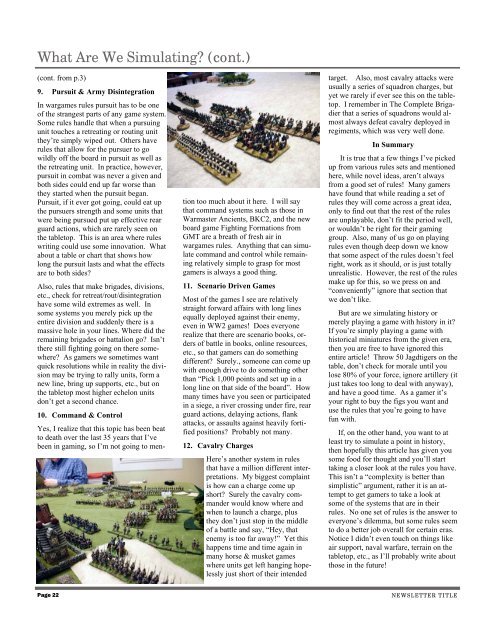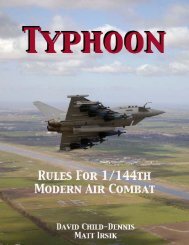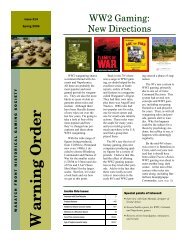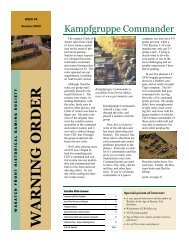Warning Order - Wasatch Front Historical Gaming Society
Warning Order - Wasatch Front Historical Gaming Society
Warning Order - Wasatch Front Historical Gaming Society
You also want an ePaper? Increase the reach of your titles
YUMPU automatically turns print PDFs into web optimized ePapers that Google loves.
What Are We Simulating? (cont.)<br />
(cont. from p.3)<br />
9. Pursuit & Army Disintegration<br />
In wargames rules pursuit has to be one<br />
of the strangest parts of any game system.<br />
Some rules handle that when a pursuing<br />
unit touches a retreating or routing unit<br />
they’re simply wiped out. Others have<br />
rules that allow for the pursuer to go<br />
wildly off the board in pursuit as well as<br />
the retreating unit. In practice, however,<br />
pursuit in combat was never a given and<br />
both sides could end up far worse than<br />
they started when the pursuit began.<br />
Pursuit, if it ever got going, could eat up<br />
the pursuers strength and some units that<br />
were being pursued put up effective rear<br />
guard actions, which are rarely seen on<br />
the tabletop. This is an area where rules<br />
writing could use some innovation. What<br />
about a table or chart that shows how<br />
long the pursuit lasts and what the effects<br />
are to both sides?<br />
Also, rules that make brigades, divisions,<br />
etc., check for retreat/rout/disintegration<br />
have some wild extremes as well. In<br />
some systems you merely pick up the<br />
entire division and suddenly there is a<br />
massive hole in your lines. Where did the<br />
remaining brigades or battalion go? Isn’t<br />
there still fighting going on there somewhere?<br />
As gamers we sometimes want<br />
quick resolutions while in reality the division<br />
may be trying to rally units, form a<br />
new line, bring up supports, etc., but on<br />
the tabletop most higher echelon units<br />
don’t get a second chance.<br />
10. Command & Control<br />
Yes, I realize that this topic has been beat<br />
to death over the last 35 years that I’ve<br />
been in gaming, so I’m not going to mention<br />
too much about it here. I will say<br />
that command systems such as those in<br />
Warmaster Ancients, BKC2, and the new<br />
board game Fighting Formations from<br />
GMT are a breath of fresh air in<br />
wargames rules. Anything that can simulate<br />
command and control while remaining<br />
relatively simple to grasp for most<br />
gamers is always a good thing.<br />
11. Scenario Driven Games<br />
Most of the games I see are relatively<br />
straight forward affairs with long lines<br />
equally deployed against their enemy,<br />
even in WW2 games! Does everyone<br />
realize that there are scenario books, orders<br />
of battle in books, online resources,<br />
etc., so that gamers can do something<br />
different? Surely., someone can come up<br />
with enough drive to do something other<br />
than “Pick 1,000 points and set up in a<br />
long line on that side of the board”. How<br />
many times have you seen or participated<br />
in a siege, a river crossing under fire, rear<br />
guard actions, delaying actions, flank<br />
attacks, or assaults against heavily fortified<br />
positions? Probably not many.<br />
12. Cavalry Charges<br />
Here’s another system in rules<br />
that have a million different interpretations.<br />
My biggest complaint<br />
is how can a charge come up<br />
short? Surely the cavalry commander<br />
would know where and<br />
when to launch a charge, plus<br />
they don’t just stop in the middle<br />
of a battle and say, “Hey, that<br />
enemy is too far away!” Yet this<br />
happens time and time again in<br />
many horse & musket games<br />
where units get left hanging hopelessly<br />
just short of their intended<br />
target. Also, most cavalry attacks were<br />
usually a series of squadron charges, but<br />
yet we rarely if ever see this on the tabletop.<br />
I remember in The Complete Brigadier<br />
that a series of squadrons would almost<br />
always defeat cavalry deployed in<br />
regiments, which was very well done.<br />
In Summary<br />
It is true that a few things I’ve picked<br />
up from various rules sets and mentioned<br />
here, while novel ideas, aren’t always<br />
from a good set of rules! Many gamers<br />
have found that while reading a set of<br />
rules they will come across a great idea,<br />
only to find out that the rest of the rules<br />
are unplayable, don’t fit the period well,<br />
or wouldn’t be right for their gaming<br />
group. Also, many of us go on playing<br />
rules even though deep down we know<br />
that some aspect of the rules doesn’t feel<br />
right, work as it should, or is just totally<br />
unrealistic. However, the rest of the rules<br />
make up for this, so we press on and<br />
“conveniently” ignore that section that<br />
we don’t like.<br />
But are we simulating history or<br />
merely playing a game with history in it?<br />
If you’re simply playing a game with<br />
historical miniatures from the given era,<br />
then you are free to have ignored this<br />
entire article! Throw 50 Jagdtigers on the<br />
table, don’t check for morale until you<br />
lose 80% of your force, ignore artillery (it<br />
just takes too long to deal with anyway),<br />
and have a good time. As a gamer it’s<br />
your right to buy the figs you want and<br />
use the rules that you’re going to have<br />
fun with.<br />
If, on the other hand, you want to at<br />
least try to simulate a point in history,<br />
then hopefully this article has given you<br />
some food for thought and you’ll start<br />
taking a closer look at the rules you have.<br />
This isn’t a “complexity is better than<br />
simplistic” argument, rather it is an attempt<br />
to get gamers to take a look at<br />
some of the systems that are in their<br />
rules. No one set of rules is the answer to<br />
everyone’s dilemma, but some rules seem<br />
to do a better job overall for certain eras.<br />
Notice I didn’t even touch on things like<br />
air support, naval warfare, terrain on the<br />
tabletop, etc., as I’ll probably write about<br />
those in the future!<br />
Page 22<br />
NEWSLETTER TITLE







